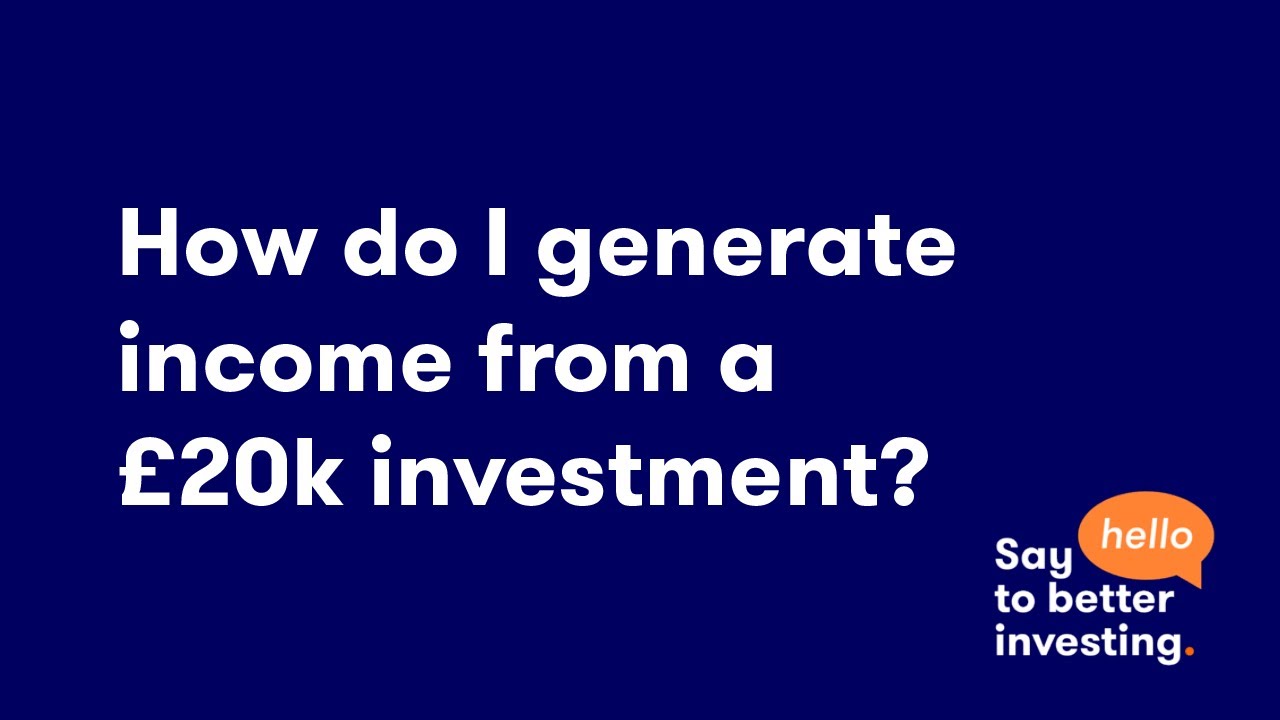£20,000 is a great amount to invest and – if you make the right choices – can make a real difference to your future financial security.
Get the lowdown on how to invest £20,000 in 2025 to make sure you make the right decisions for you.

Should I save or invest £20,000?
As a starting point you need to decide whether you should invest your £20,000 or keep it in a cash account. There are pros and cons to both approaches.
Saving
The advantage of cash is that it’s low risk. Your money will earn a known rate of interest and you won’t make any losses. The catch is that even with interest rates rising, you may not get the growth you need to achieve your financial goals. You may also find that over the years your money is eroded by inflation and its spending power reduced.
Investing
The risk with stock market linked investments is that performance isn’t guaranteed and you may lose money, especially over the short term. However, if you have a reasonable amount of time to invest (five years at least) you should be able to ride out short-term volatility and your money is likely to achieve greater growth..
Working out what is the right route for you will depend on where you are in life as well as your financial circumstances. Before you make any decisions it’s worth thinking about the following:
- Ideally you should be able to tie up your money for the next five to 10 years. If you are going to have some major expenses over the next few years (think house deposits, weddings, starting a family, home renovations and so on) – it pays to make sure you have the money you need in a cash account.
- You’ll still need cash for emergencies. It’s a good idea to keep three to six months expenses in an instant access savings account. An emergency or rainy-day fund means you don’t have to risk selling investments at the wrong time if you’re faced with any unexpected expenses.
- Your debt position: If you’ve got any expensive debts like credit cards or personal loans, it makes sense to pay those down before you invest. Mortgage rates are normally lower, but you may also want to consider the benefits of making a lump sum overpayment on your mortgage. If you’re unsure how to proceed you can always invest part of your £20,000 and keep the remainder in cash savings.
Where to invest £20,000
If you decide to invest all or some of your £20,000, you’ll need to plan how to buy your investments.
The easiest option is to open an account with an online investment platform.
You’ll need to pay a fee to use a platform, so it’s important to shop around to get the best value for money.
Interactive Investor offers a range of flat fee options, starting from £4.99 a month. A flat fee (rather than a percentage-based charge) means you know what you are paying each month as your costs won’t grow with your investments.
The next step is to decide what sort of account you need. Your platform will give you a number of options and which one works best for you will depend on your circumstances.
A Stocks and Shares ISA
Money invested in an ISA is sheltered from tax while it grows and there will be no tax to pay when you withdraw money either. Conveniently, you can invest £20,000 into an ISA each year. Even though it’s best to invest for the long term, your money is accessible whenever you need it.
A Self Invested Personal Pension
Investing in a pension means your money is sheltered from tax while it grows. Although your money may be taxable when you withdraw it, you get the benefit of tax relief on your contributions, equivalent to the highest rate of income tax you pay. You can’t however access your money until you are 55 (rising to 57 in 2028). If you are making a large investment into your pension, it’s important to be aware of the annual allowance, which limits your contributions to 100% of your income, up to a maximum of £60,000 a year.
Choosing your investments
Whether you choose a stocks and shares ISA, a SIPP or a trading account, you’ll still get access to the same choice of investments.
This includes fixed-interest securities like corporate bonds and gilts as well a stock market linked investments and commodities, for example:
- Shares: direct holdings in companies listed on UK and overseas stock markets
- ETFs: exchange-traded funds are investment funds that are traded like shares, enabling investors to access a broad basket of stocks that tracks an index. ETFs can also be used to invest in bonds, property and currencies
- Funds: a collective investment in a portfolio of shares that is managed on your behalf by a fund manager
- Investment trusts: another form of collective investment, but unlike funds they are structured as companies and listed on the stock exchange
Where to start when you’re investing £20,000
With so many options available it’s often hard to know where to start.
Direct share holdings can be risky, particularly for new investors. It normally makes sense choosing a collective investment like a fund, investment trust or ETF. This will be lower cost, easier to manage and give you more diversification.
If you need inspiration ii has a range of ideas to help you begin. This includes our Quicksstart funds, ii Super 60 – our list of expert rated funds as well as five model portfolios. We also have the ACE 40 list of best-in-class sustainable investments.
What are the risks of investing £20,000?
If you invest a lump sum when markets are moving upwards, you’ll start seeing positive returns, fast. Unfortunately, though, if markets are falling you could end up with a quick loss. You should be able to recoup your losses over time, but it’s clearly best to try and get off to a good start.
If you’re concerned about investing a lump sum, you can mitigate the risk by investing £20,000 gradually. You can, for example, break it up into several smaller lump sums, or use your cash to fund a regular investment plan.
Regular investing allows you to drip-feed money into the stock market each month and take advantage of pound-cost averaging. This means you don’t buy all your shares at one price and get an average price over time, giving you smoother returns. You also get the benefit of buying more shares when prices are lower.
This doesn’t necessarily mean you’ll get better returns (with lump sum investing your money will be in the market longer) but it can be less stressful and reduces any desire to try and time the market.
Tips for investing £20,000
Ensure your portfolio is diversified
Investing across a broad spread of shares and asset classes reduces risk. If one holding performs badly, it doesn’t drag all your portfolio down with it. Think of it like spreading your bets.
Watch your charges
Consider investing in passive funds which replicate the performance of your chosen index. They are much cheaper than actively managed funds and often achieve similar results.
Make sure your investment is tax effective
If your money is not held in a tax-free wrapper like an ISA or pension, you may have to pay tax on your proceeds.
Don’t let emotion get in the way
It’s important not to let your heart rule your head. Successful investing takes time and when markets are volatile it usually makes sense to hold your nerve, not panic and sell.
Don’t get bogged down trying to pick the ‘right’ funds
It doesn’t matter if you don’t pick the absolute top performer. It’s length of time in the market and asset allocation that really matters.
Think about risk
Your investments shouldn’t keep you awake at night, but not taking enough risk could mean you don’t get the returns you need. This means it’s important to be level-headed and take a calculated risk. As a general rule, the longer you have until you need your money, the more risk you can afford to take. You can always reduce risk further down the line as you near retirement or your objectives change.
